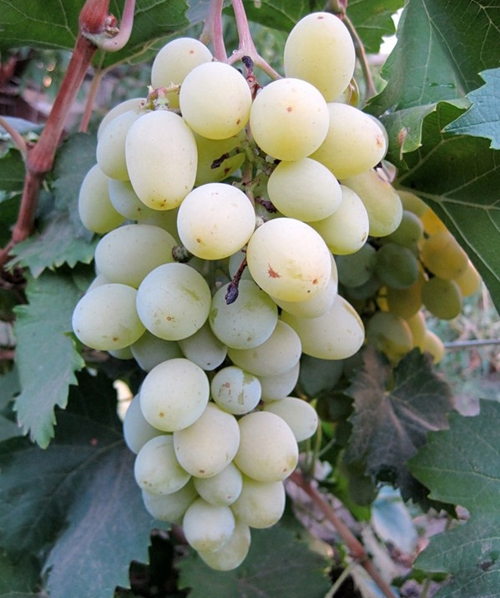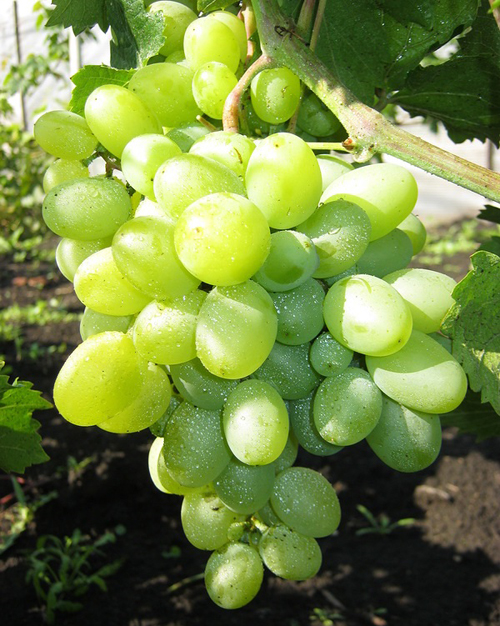Grape variety Gift to Zaporozhye
A present for Zaporozhye is a popular table hybrid of grapes. Bred in Ukraine in the society of winegrowers "Grape Elita" by the famous national breeder Yevgeny Alekseevich Klyuchikov. The society was formed in the early 90s of the XX century and set itself the task of creating and testing new varieties of grapes. In the case of the Gift to Zaporozhye, these tasks were accomplished very successfully, enriching the world collection of grapevine varieties with another more than worthy representative. The new hybrid really became a gift, not only to Zaporozhye, but also to all amateur winegrowers, who quickly spread it over a very large territory.

A hybrid was obtained based on the pollination of a known Mascot a mixture of pollen from grape forms V-70-90 and R-65. The choice of the Talisman as the mother form is not accidental. Due to the functionally female type of flowering and the outstanding genetically determined parameters of the bunch, it is very popular among amateur breeders for its ease of hybridization with other varieties and the constant transfer of large-fruited genes to its offspring.
So the Gift to Zaporozhye forms large, attractive in shape and size brushes and berries, however, unlike other fellows in amateur selection, the author, using the genes of his father's form, endowed his brainchild with high indicators of resistance to disease and frost, while usually the emphasis is exclusively to improve the aesthetic parameters of the bunches alone. The justified cost of this approach was the rather average estimates of the expressiveness of the taste and appearance of the berries. Often, grapes, even after full ripening, remain green, and with an incorrectly selected load, they also acquire a mediocre watery consistency. For the sake of fairness, it should be noted that the latter problem is completely removable and is not a predetermined characteristic of the variety.
Agrobiological characteristics
Bushes with great vigor. The shoots are powerful. The leaves are large, rounded, three-lobed, slightly dissected, dark green in color. Lateral notches barely marked; petiole notch open, slit-like. The denticles along the edge of the leaf are large, triangular, with a wide base. There is a small cobweb pubescence on the underside of the leaf. Flowers of the Gift to Zaporozhye with a functionally feminine type of flowering, require the presence of a number of pollinators.

Bunches of grapes are large and very large (average weight 600-900 grams, but specimens grow up to 2 kg), conical or cylindro-conical, usually quite dense, but can also be loose. The comb is strong, of medium length, the stems of the berries are short and strong. The berries of the variety are large, usually leveled, about 32 × 28 mm in size, weighing 10-12 grams or more, oval-nipple-shaped. The brushes are not crushed. The pulp is fleshy-juicy, sweet, harmonious in taste with a subtle apple aroma. The skin is firm, dense, green or light green, covered with a moderately intense white prune bloom. The berry contains from 1 to 3 medium-sized seeds. The berries do not crack, they are well preserved on the bushes after ripening, if you take care of protection from being eaten by wasps.
The crop is intended for fresh consumption. Has an average transportability. If the Gift to Zaporozhye is somewhat inferior to some other varieties of grapes in terms of attractiveness of color, then it does not at all lose to them in terms of the size of bunches, and in terms of evenness of berries in a bunch, it is ahead of many of them. All this as a whole determines the rather high marketability of the variety and the interest in it from the side of buyers.
An early-medium hybrid, it takes about 130-140 days from budding to ripening. The sum of the active temperatures required for the ripening of the bunches is 2750-2850 ° C. The yield is high.Up to 30 kilograms of excellent quality grapes are harvested from an adult, powerful, well-developed bush, without prejudice to the bush itself, which, even after such a bountiful harvest, manages to prepare well for winter. The frost resistance of the Gift to Zaporozhye is very significant - up to -24 ° С. The fruitfulness of the shoots reaches 75%. On each shoot, an average of two clusters can form. The sugar content of the berry juice is 16-18 g / 100 cubic meters. cm, acidity - 6-8 g / liter.

Agrotechnical features
Given the complex resistance of our hero to diseases and low winter temperatures, the main attention of the grower during its cultivation should be paid to the correct formation of the plant, the optimal load of its shoots and harvest, good pollination by other varieties of grapes.
High frost resistance allows you to grow the variety without shelter for the winter on a high trunk and even in arched and arbor cultures. The hybrid enters fruiting early, already in the second or third year after planting. Large formations are preferable for the Gift of Zaporozhye due to the high vigor of bushes growth, responsiveness to the accumulation of perennial wood, thanks to which the plants reserve plastic substances and have more vitality for laying, growing and ripening a large harvest.
The total load must be clearly regulated in the spring during pruning, and at the beginning of the growing season by the so-called "green weeding". It is necessary to remove damaged, sterile and weak shoots, as well as all "doubles" and "tees" that thicken the bush and take away food from it. This should be done as early as possible, since the grown shoots do not break off well. The recommended load on an adult bush is 40-45 eyes, but it can vary up or down depending on the specific conditions of growth and development. The evidence of underloading will be the appearance of fattening shoots, and overloading, especially significant, on the contrary, is a weak growth of the vine, a delay in the ripening of grapes, a fresh taste and a watery consistency of berries. And one and the other state oppresses the bush, especially if it is repeated for several years in a row.
And, of course, like other hybrids with a female type of flowering, the Gift of Zaporozhye needs a neighborhood with bisexual varieties blooming at the same time. This is usually sufficient for good quality cross-pollination, so tedious manual work in this direction is not required. Many growers, however, are not limited to this, treating the inflorescences with a growth stimulant Gibberellin. This allows you to achieve even more uniform and large berries in comparison with the standard, as well as, often, the absence of seeds in them.
Treatment of the vineyard against diseases can be limited to one or two preventive spraying in unfavorable weather years. Gift cuttings to Zaporozhye root perfectly, however, in areas where phylloxera is rampant, it is better to refrain from self-rooted plantings due to the definitely not established resistance of the variety to this pest.
Thus, we have before us a variety of grapes that is problem-free from the point of view of disease resistance, which at the same time requires careful implementation of certain agrotechnical methods aimed at ensuring high taste qualities of the future harvest. Agree, this is much more attractive than poisoning yourself and others with chemistry from endless treatments of disease-susceptible varieties.









Planted in the spring of 2005. 1 - 2 brushes were left on a young bush. I liked both the taste and the appearance of the berries. The fruits are sweet, very large. I got older, the taste of the berries worsened, and wateriness appeared. I started to get sick more often. We were already going to remove it, but realized our mistake - they left too many brushes. A gift to Zaporozhye more than all our other varieties needs to be shaped. In spring, 2 - 3 shoots develop from one internode, at least 5 - 6 brushes are formed on a branch. If you remove about 80% of the ovary, you get beautiful large clusters with excellent taste. In addition, we cut off a lot of green mass, it builds up very quickly, even without additional watering. If you remove a little, the grapes get sick and ripen worse. At the end of the season, before frost, we do not cover. A couple of times during a particularly cold winter, the branches were partially frozen, but the bush was not badly damaged. We spray for diseases several times a season. We process it with a stimulant during flowering so that the berries do not peas. You can not harvest for a long time, the taste of the grapes does not suffer.